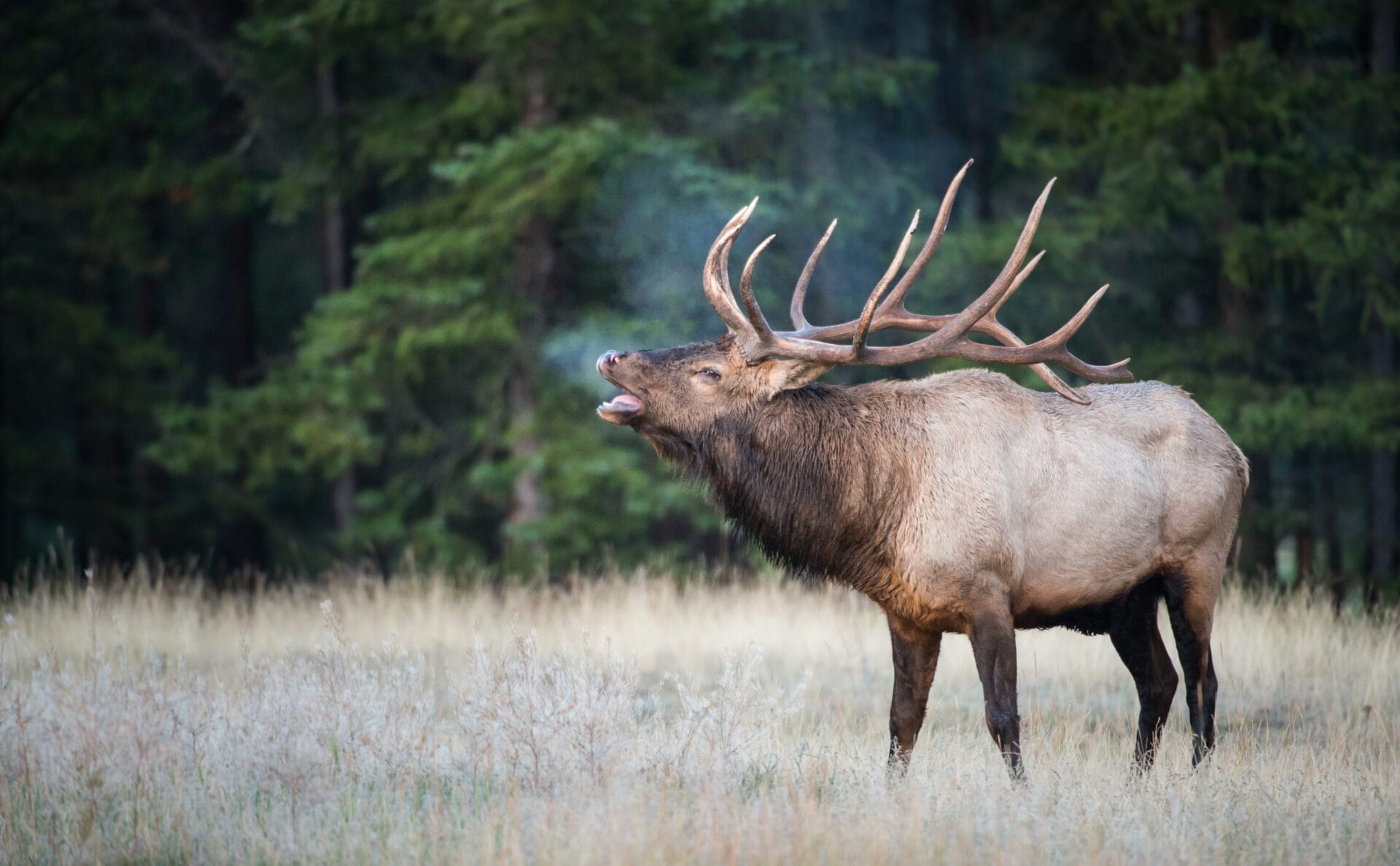A close encounter with Breckenridge’s wildlife can be both a delight and a fright. Seeing a moose or bear from the safety of your vehicle is exciting. But imagine running into one on the trail! Wildlife abounds in the Breckenridge area. And with our proximity to White River National Forest lands, Beaver Run Resort frequently sees wild animals. Here is a guide to commonly seen wildlife in Breckenridge and how to best enjoy them.
General Guidelines
In general, distance is safety. If you do get too close to wildlife and need to defend yourself, the Colorado Department of Parks and Wildlife urges us to be SMART. S = Stop. Do not run as many animals will chase. (Exception: moose). M = Make yourself look big. Put your arms over your head, raise up your jacket, look like a formidable foe. A = Announce your presence. Firmly say “Leave me alone!” R = Retreat. Slowly back away, do not turn your back to an animal. T = Tell an adult. Or if you are an adult, tell a friend you are glad you survived your encounter.
Another good guideline is to never feed the animals. Don’t give a muffin to a moose, a biscuit to a bear, or fudge to a fox. Feeding animals habituates them to humans.
Most Dangerous Wild Animals in the Breckenridge Area
Let’s start with the big animals that can cause harm to humans if not given plenty of space. Breckenridge is home to moose, bear, mountain lions and coyotes. Viewing any one of these animals in their native habitat will ensure lasting memories. But the key word is “viewing.” It’s important to view from a safe distance and avoid close encounters.
Bears
Black bears inhabit the woods around Breckenridge. The name Black Bear indicates their species, though they can be brown, cinnamon or blonde. We don’t have grizzlies or other aggressive bear species. Black bears are usually more afraid of you than you are of them. Most bear sightings happen early in the morning or in the evening.
For guests at Beaver Run Resort, the most likely opportunity to see a bear would be on a hike. For a safer experience in bear country, avoid surprising a bear by being alert at all times, not using headphones, and keeping your dog on a leash. Keep children near and don’t let them run ahead or fall behind. Never approach bears or offer food. If your presence causes the bear to look up or change its behavior in any way, you are too close.
If you surprise a bear, stand still, stay calm, and give the bear an escape route to leave. Never run or climb a tree as the bear may pursue. If you see cubs, their mother is usually close by and you’ll want to leave the area immediately. If the bear does not leave, wave your arms slowly overhead, talk calmly in a normal tone of voice. Keep the bear in sight as you slowly back away. If the bear approaches you, she may be food-conditioned by other humans. Stand your ground, yell, throw rocks in the bear’s direction. If you have bear spray, be prepared to use it at about 40 feet of distance. If attacked, fight back with anything available.
Learn more about bear encounters from Colorado Parks and Wildlife at this link.
Moose
Curious creatures, moose are seen on social media peering in windows or walking the streets of Breckenridge. Large, lumbering, slow moving: moose appear to be docile and almost tame. But looks are deceiving. Never try to get near a moose. They are one of the deadliest mammals in North America and will trample a threatening human.

Of major concern are our dogs. Moose don’t distinguish between a dog and a wolf, their greatest predator. A threatened moose will chase a dog. That dog may come running back to you with an angry moose on its heels wanting to crush the dog and you with its massive hooves.
Even without a dog nearby, moose will aggressively defend their young and their territory. Signs of moose aggression include laid back ears, raised hairs on the neck, and licking of the snout. Avoid animals that are behaving belligerently by backing away quickly and leaving the area. If a moose displays aggressive behavior or begins to charge, run as fast as you can and quickly try to put a large object between you such as a boulder, car or tree.
Learn more about moose behavior from CPW at this link.
Mountain Lions

Even though it is rare, mountain lions have been seen in the Breckenridge are from time to time. Like the black bear, mountain lions are wary of humans and avoid interaction. Unlike the moose, mountain lion attacks on humans are very rare, with fewer than a dozen fatalities in the last 100 years in North America. Young lions are most likely to get close to humans and may prey on pets and small children.
Because human attacks by mountain lions are so rare, CPW offers little guidance on what to do, with the following suggestions to keep in mind: go in groups; make noise when in lion country; use a walking stick; keep dogs on leash and children nearby. If you encounter a mountain lion, follow the same protocols as for bear. Teach children to stay calm, or better yet, pick them up so they don’t run. If the lion is aggressive, don’t bend down or turn your back to pick up rocks or branches, but do find something to throw at the animal. Keep standing. Fight back. Be a danger to the lion.
Learn more about mountain lions from CPW at this link.
Coyotes
One of the smartest of the wild animals, coyotes’ ability to adapt has allowed them to take advantage of human-centered environments. They’ll prey on pets and other domestic animals, and eat trash or road kill. Like bear, coyote will generally avoid humans during daylight hours. If a coyote approaches you or appears aggressive, follow the same steps as for a bear encounter. Provide extra protection for pets by keeping them leashed and indoors at night. Pick up small pets and never allow pets to “play” with coyotes.
Learn more about coyotes from CPW at this link.
Less Aggressive Wild Animals
Elk, deer, red fox, beaver, marmots, weasels, pine martens, salamanders, boreal toads, squirrels, chipmunks, field mice, and birds, lots of birds. These are some of the many species of wildlife that you may be privileged to see in the Breckenridge area. In general, these animals are not a threat to humans. But humans can be a threat to them. Avoid close encounters, view from a safe distance, and never feed wildlife. Do take plenty of photos.
Birds
From year-round residents to migratory visitors to birds of prey, Breckenridge sees a huge variety of birds throughout the year. Some of our favorites include the Canada Jay, sometimes called Camp Robbers for the obvious reason that they will take advantage of unattended picnics to steal food. Chickadees are year-round residents in our mountains. Pine Grosbeaks sing a lovely song. Robins are the first to arrive in spring. Hummingbirds announce their presence with their high-pitched whiz. Breckenridge also frequently sees Coopers and Sharp-Shinned Hawks, Red Tails and Ospreys. Bald Eagles sometimes hunt in the Blue River.
Fear of a wildlife encounter should not deter you from enjoying the natural beauty that surrounds Breckenridge and Beaver Run Resort. By following safe protocols, recreating during daylight hours, and staying aware of your surroundings, you may be blessed with a memorable wildlife sighting and lasting images. In fact, we hope you get to see some of Breckenridge’s wild animals while you are visiting. It is truly one of the best things about a vacation in the mountains of Breckenridge. We hope to see you here at Beaver Run Resort soon!









